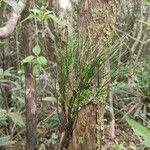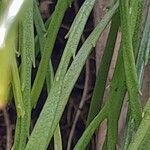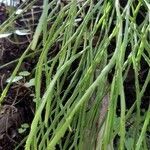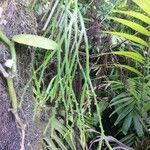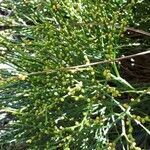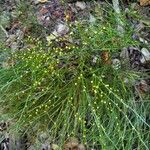Epiphytic or terrestrial plant. Rhizome branching, creeping, but often clumped. Aerial shoots erect, firm or sometimes flaccid in shaded situations, branched repeatedly in different planes in the upper part, 10–85 cm long. Branches prominently 3–7-ribbed, subterete in cross-section, to 4.5 mm diam.; stomata restricted to furrows between ribs. Sterile leaves restricted to ribs, subspiral, 1–2.5 mm long, terete, pale yellow, translucent towards the tips. Synangia 1.5–2 mm long, 2–2.5 mm wide. [See also Du Puy (1993: 535), Green (1994: 547).]
Rhizomes creeping, terete, brown, with dense rhizoids. Aerial stems erect to somewhat pendulous, green, with dense white stomata, 15-50 cm, 0.8-1.5 mm wide, glabrous, unbranched proximally, distally repeatedly dichotomously branched, 3-angled or-ridged. Trophophylls subulate-triangular, 1-2 mm, herbaceous; sporophylls deeply bifid, lobes narrowly subulate, 2-3 mm. Sporangia yellow to yellowish brown, obtriangular-globose, 3-4 mm in diam., (2 or)3-lobed. 2n = 104, 208, ca. 312.
Rhizome up to 1.5 mm in diam., short-creeping, branched, lacking true roots, but with rhizoids. Aerial stems green, angular, once of several times equally forked, up to 160 mm long, up to 2 mm in diam., erect or pendent, with rudimentary simple, lance-shaped enations, broadly attached, up to 1.5 mm long. Synangia 2-or 3-locular, up to 2.5 mm in diam., borne in axil of forked enations near branch ends, locules dehisce with a longitudinal slit.
Epilithic or occasionally epiphytic. Rhizome short, rootless. Stems triangular in cross-section, glabrous, up to 240 mm high. Leaves rudimentary, simple, widely spaced, up to 1.5 mm long. Sporangia fused to form sessile synangium, each subtended by a bifurcate bract.
Rhizome short, rootless, ± 1.5 mm in diameter. Aerial stems triangular in cross-section, glabrous, up to 240 x 2 mm, with widely spaced, lanceolate scale leaves up to 1.5 mm long. Sporangia ± 2.5 mm in diameter, each subtended by a bifurcate bract, ± 1.3 mm long.
Aerial axis up to 4 dm. long, erect, much branched, branchlets triquetrous. Lobes on angles of axis and branchlets, 2-4 mm. long, ovate-subulate. Sporangia subsessile, globose, subcoriac., 1·5-3 mm. diam., 3-lobed, 3-celled.
A naked herb without roots. The stems are like chickens feet. It grows 60 cm long. It can be erect or hang down. It can grow attached to other plants. It has creeping rhizomes.
Aerial shoots to 50 cm, 4 mm diam. at base. Appendages 0.7--2.5 mm (sterile), 1--1.5 mm (fertile). Synangia yellowish to greenish yellow, 2--3 mm wide.
